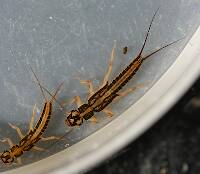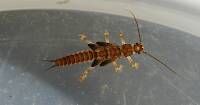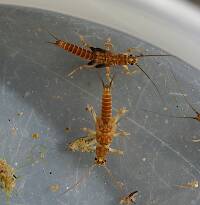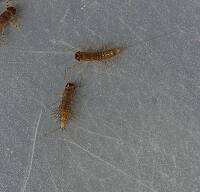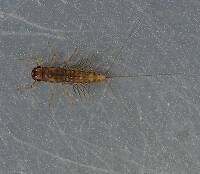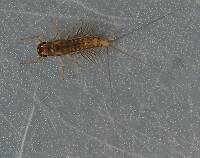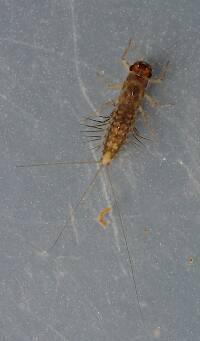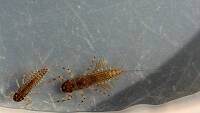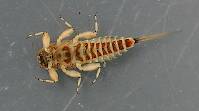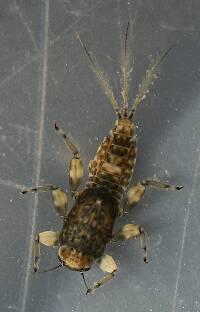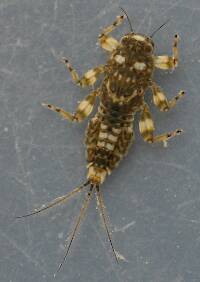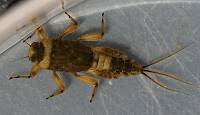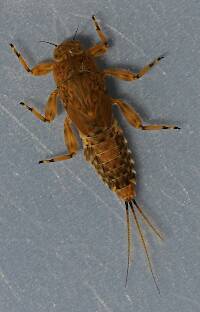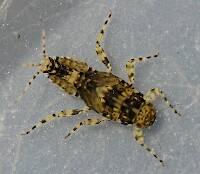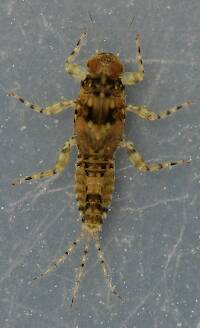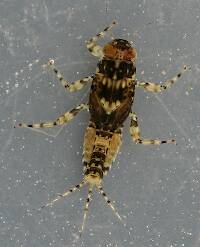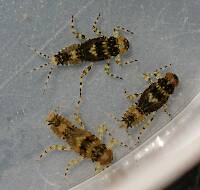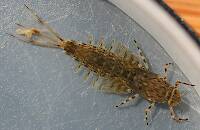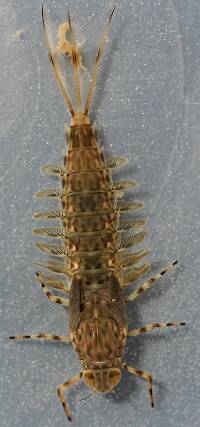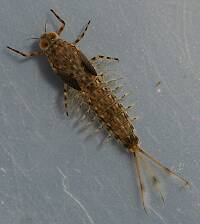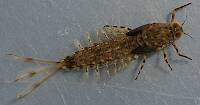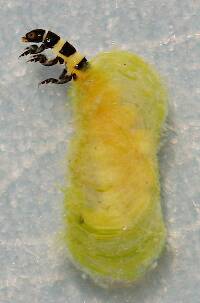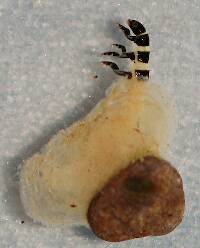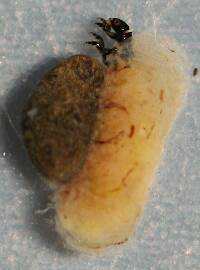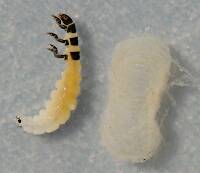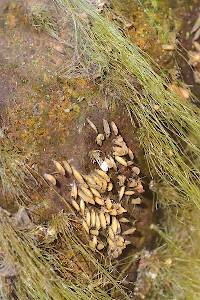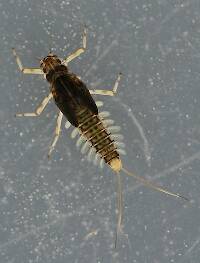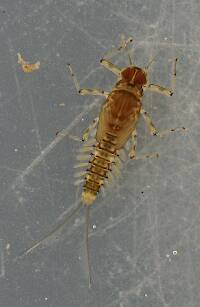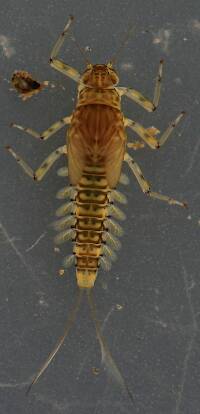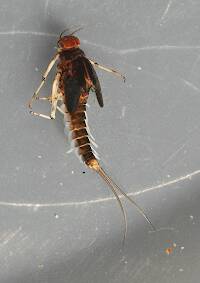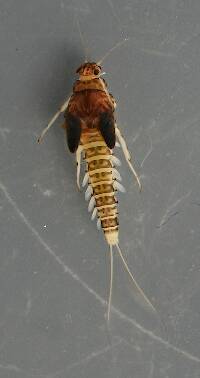
Blue-winged Olives
Baetis
Tiny Baetis mayflies are perhaps the most commonly encountered and imitated by anglers on all American trout streams due to their great abundance, widespread distribution, and trout-friendly emergence habits.
Featured on the forum

Some characteristics from the microscope images for the tentative species id: The postero-lateral projections are found only on segment 9, not segment 8. Based on the key in Jacobus et al. (2014), it appears to key to Neoleptophlebia adoptiva or Neoleptophlebia heteronea, same as this specimen with pretty different abdominal markings. However, distinguishing between those calls for comparing the lengths of the second and third segment of the labial palp, and this one (like the other one) only seems to have two segments. So I'm stuck on them both. It's likely that the fact that they're immature nymphs stymies identification in some important way.

Troutnut is a project started in 2003 by salmonid ecologist Jason "Troutnut" Neuswanger to help anglers and
fly tyers unabashedly embrace the entomological side of the sport. Learn more about Troutnut or
support the project for an enhanced experience here.
By Troutnut on August 14th, 2020, 6:15 pm EDT
I've been using this book a lot to identify new insect specimens for the last two summers and wanted to share some quick thoughts. An Introduction to the Aquatic Insects of North America is the definitive technical reference for identifying aquatic insects (at least to family or genus level) and has been for decades.

The 5th Edition seems like one of the most significant updates yet, especially for mayflies, as it incorporates many of the taxonomic changes of the last decade or so (for example, splitting off a lot of Paraleptophlebia into Neoleptophlebia, and various changes to the Baetids). It also adds color plates, which are a nice touch, although I think the print medium is inherently very limited in that regard. That's one reason I started this site--so people can see each bug close-up and from many angles.
I've been very impressed by the level of thought that went into producing thorough keys. For example, recent keys (based Jacobus & McCafferty 2008) identify Ephemerella tibialis (formerly Serratella tibialis) nymphs based on some small, subtle features (tiny brown "excresences" on parts of the thorax and serrations on the maxillary canine) that are difficult to detect or picture from written descriptions. One of the primary sources includes electron microscope pictures of the excresences, but I don't have any electron microscopes. This book, however, contains pretty good drawings of both features (Fig. 13.85 and 13.90) which weren't found in any of the primary sources I checked, allowing me to make a more confident ID. There are still occasional couplets in the keys for which a better diagram would be helpful, but overall their coverage is really impressive.
It may sometimes be a bit dissatisfying to anglers that they can't identify most mayflies or caddisflies to the species level with this text, only to genus. That's an unfortunate reality of the difficulty of that task; this book wouldn't even fit into a binding if it contained species keys. Anglers wanting to pin an exact species name on their specimens need to either refer to the scientific literature or the angling literature. The keys in the primary scientific literature are often difficult and require looking at tiny features under a microscope with deep knowledge of insect anatomy. Even then, many species aren't fully described. Keys in books for anglers, when available, are a lot easier to follow but tend to be incomplete (especially for western species) and use characteristics that aren't 100 % reliable. For genus-level identifications, this book is as rigorous and up-to-date as anything out there. Some genus identifications can still be frustrating (for example, distinguishing Baetis nymphs from some related Baetidae passes through a couplet describing a "villipore" which is practically impossible to see with amateur equipment). However, that's more a problem for the taxonomists to figure out than for the textbook that compiles all their work. It's just a head-up to the reader that not all genus IDs will be easy, even for well-known genera.
One small inconvenience with this book is that it's almost a victim of outgrowing the printed page. There are so many useful illustrations that they can't all fit on the pages where they're needed, so using the keys means hunting back and forth a few pages at a time almost constantly to reference the relevant figures. I look forward to a time when this information is all available digitally, and not just as a scan of the printed pages, but in a format where illustrations (and perhaps also definitions) always appear where needed.
Another side effect of the book being so comprehensive is that the keys are pretty long and cover everything, so an angler is likely to end up squinting at some odd little insect body parts just to rule out a rare mayfly that only lives on the silty bottoms of large warm rivers 3,000 miles away. The keys become much easier to use once you have some experience, including knowledge of the basic appearance of most of the families and their ranges, to know which taxa to skip over at a glance en route to the real prospects. Roger Rohrbeck's Flyfishing Entomology website has distribution maps that are a very helpful supplement to these keys. Books written primarily for anglers omit these rarities altogether, but that has its own downside, because it's fairly common to find something unusual that isn't in the anglers' books. So it's beneficial to use the full keys, but often enough that you learn which parts to skip and why.
I would highly recommend this edition as an upgrade for those who are or would like to become serious angler-entomologists, especially if your previous edition is the 3rd or earlier, or if you don't have it at all yet. It would not be the right book for somebody completely new to aquatic entomology, unless maybe they have a degree in biology and are looking to dive in deep.

The 5th Edition seems like one of the most significant updates yet, especially for mayflies, as it incorporates many of the taxonomic changes of the last decade or so (for example, splitting off a lot of Paraleptophlebia into Neoleptophlebia, and various changes to the Baetids). It also adds color plates, which are a nice touch, although I think the print medium is inherently very limited in that regard. That's one reason I started this site--so people can see each bug close-up and from many angles.
I've been very impressed by the level of thought that went into producing thorough keys. For example, recent keys (based Jacobus & McCafferty 2008) identify Ephemerella tibialis (formerly Serratella tibialis) nymphs based on some small, subtle features (tiny brown "excresences" on parts of the thorax and serrations on the maxillary canine) that are difficult to detect or picture from written descriptions. One of the primary sources includes electron microscope pictures of the excresences, but I don't have any electron microscopes. This book, however, contains pretty good drawings of both features (Fig. 13.85 and 13.90) which weren't found in any of the primary sources I checked, allowing me to make a more confident ID. There are still occasional couplets in the keys for which a better diagram would be helpful, but overall their coverage is really impressive.
It may sometimes be a bit dissatisfying to anglers that they can't identify most mayflies or caddisflies to the species level with this text, only to genus. That's an unfortunate reality of the difficulty of that task; this book wouldn't even fit into a binding if it contained species keys. Anglers wanting to pin an exact species name on their specimens need to either refer to the scientific literature or the angling literature. The keys in the primary scientific literature are often difficult and require looking at tiny features under a microscope with deep knowledge of insect anatomy. Even then, many species aren't fully described. Keys in books for anglers, when available, are a lot easier to follow but tend to be incomplete (especially for western species) and use characteristics that aren't 100 % reliable. For genus-level identifications, this book is as rigorous and up-to-date as anything out there. Some genus identifications can still be frustrating (for example, distinguishing Baetis nymphs from some related Baetidae passes through a couplet describing a "villipore" which is practically impossible to see with amateur equipment). However, that's more a problem for the taxonomists to figure out than for the textbook that compiles all their work. It's just a head-up to the reader that not all genus IDs will be easy, even for well-known genera.
One small inconvenience with this book is that it's almost a victim of outgrowing the printed page. There are so many useful illustrations that they can't all fit on the pages where they're needed, so using the keys means hunting back and forth a few pages at a time almost constantly to reference the relevant figures. I look forward to a time when this information is all available digitally, and not just as a scan of the printed pages, but in a format where illustrations (and perhaps also definitions) always appear where needed.
Another side effect of the book being so comprehensive is that the keys are pretty long and cover everything, so an angler is likely to end up squinting at some odd little insect body parts just to rule out a rare mayfly that only lives on the silty bottoms of large warm rivers 3,000 miles away. The keys become much easier to use once you have some experience, including knowledge of the basic appearance of most of the families and their ranges, to know which taxa to skip over at a glance en route to the real prospects. Roger Rohrbeck's Flyfishing Entomology website has distribution maps that are a very helpful supplement to these keys. Books written primarily for anglers omit these rarities altogether, but that has its own downside, because it's fairly common to find something unusual that isn't in the anglers' books. So it's beneficial to use the full keys, but often enough that you learn which parts to skip and why.
I would highly recommend this edition as an upgrade for those who are or would like to become serious angler-entomologists, especially if your previous edition is the 3rd or earlier, or if you don't have it at all yet. It would not be the right book for somebody completely new to aquatic entomology, unless maybe they have a degree in biology and are looking to dive in deep.
Comments / replies
Jmd123 on Aug 17, 2020August 17th, 2020, 3:49 am EDT
I have the 4th edition, Jason. How does it compare?
Jonathon
Jonathon
No matter how big the one you just caught is, there's always a bigger one out there somewhere...
Partsman on Aug 18, 2020August 18th, 2020, 10:23 am EDT
Jason, Im that person you describe, I have a deep interest in the bugs on the rivers I fish, not only from a angling aspect, but also just from a how healthy are the streams I fish aspect. And its just cool to what the heck is going on in our world from a biological standpoint. I wont lie, the price of the book is somewhat prohibitive for joe flyfishermen, but I think its for me a least its worthwhile.
Thanks, Mike.
Thanks, Mike.
Troutnut on Aug 18, 2020August 18th, 2020, 12:17 pm EDT
Jonathan, the added color plates are nice and there have been some updates to mayfly taxonomy (among others) since the 4th Edition, but I haven't had time to flip back through that one and make a detailed side-by-side comparison. I know the 5th Edition reflects any of the recent changes I've seen in the literature, although I haven't been following new papers right as they come out. Things like the Paraleptophlebia/Neoleptophlebia split are certainly included in the 5th.
Jason Neuswanger, Ph.D.
Troutnut and salmonid ecologist
Troutnut and salmonid ecologist
Crepuscular on Aug 19, 2020August 19th, 2020, 8:33 am EDT
What? no comments on the line drawing of the Culicids? ;)
Quick Reply
Related Discussions
Topic
Replies
Last Reply
0
Feb 21, 2018
by Millcreek
by Millcreek
16
May 20, 2008
by Shawnny3
by Shawnny3
3
Oct 30, 2009
by Doublezz105
by Doublezz105






